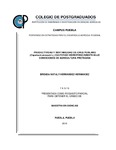Productividad y rentabilidad de chile poblano (Capsicum annuum L.) cultivado hidropónicamente bajo condiciones de agricultura protegida.
Abstract
El cultivo de chile poblano criollo sembrado en suelo es característico de la región del Alto Atoyac en Puebla, desde hace varios años, se ha visto afectado por factores ambientales y problemas ocasionados por fitopatógenos del suelo causantes de diversas enfermedades de la raíz, que han originado daños en el cultivo al grado de orillar al productor a reducir la superficie anual plantada, generando una reducción en los rendimientos esperados y en el ingreso por la venta del fruto. La presente investigación se llevó a cabo con el objetivo de conocer las características del sistema de producción tradicional de chile poblano en la región del Alto Atoyac; evaluar la productividad de dos variedades criollas de chile poblano y un hibrido bajo condiciones protegidas e hidroponia; y determinar la rentabilidad de ambos sistemas de producción a través de los indicadores económicos VAN, TIR y B/C. Se realizaron entrevistas a una muestra de 20 productores de la región para identificar las características sociales, agronómicas y económicas del sistema de producción; los resultados indicaron que el cultivo se establece de manera tradicional a cielo abierto, utilizando semilla nativa de la región, la superficie plantada varía de los 400 m2 hasta 3 ha y el rendimiento promedio del cultivo es de 5 t ha-1. La evaluación de variedades de chile poblano se realizó en un invernadero de 100 m2 y se evaluaron tres concentraciones de la solución nutritiva Steiner: 50, 75 y 100 %; los resultados mostraron diferencias significativas entre las variedades evaluadas debido a la aplicación de los tratamientos. De acuerdo al análisis de la rentabilidad de los sistemas de producción evaluados, la viabilidad económica del chile poblano producido en invernadero e hidroponia, es mayor a la obtenida en el sistema de producción tradicional a cielo abierto. _______________ PRODUCTIVITY AND PROFITABILITY OF POBLANO CHILE (Capsicum annuum L.) HYDROPONICALLY CULTIVATED UNDER CONDITIONS OF PROTECTED AGRICULTURE. ABSTRACT: The cultivation of creole poblano chile sown in soil is characteristic of the Alto Atoyac region in Puebla, for several years now, it has been affected by environmental factors and problems caused by soil phytopathogens which cause various diseases of the root that damage the crop, to the degree of forcing the producer to reduce the annual planted surface, generating a reduction in the expected yields and in the income by the sale of the fruit. The present investigation was carried out with the objective of knowing the characteristics of the traditional production system of poblano chile in the Alto Atoyac region; evaluate the productivity of two creole poblano chile varieties and one hybrid, under protected conditions and hydroponics; and determine the profitability of both production systems through the economic indicators VAN, TIR and B/C. Interviews were conducted with a sample of 20 producers in the region to identify the social, agronomic and economic characteristics of the production system. The results indicated that the crop is established in a traditional way in the field, using native seeds of the region; the planted area varies from 400 m2 to 3 ha and the average yield of the crop is 5 t ha-1. The evaluation of poblano chile varieties was carried out in a 100 m2 greenhouse and three concentrations of 50, 75 and 100 % the Steiner nutrient solution were evaluated. The results showed significant differences between the varieties evaluated due to the application of the treatments. According to the analysis of the profitability of the production systems evaluated, the economic viability of the poblano chile produced in greenhouse and hydroponics is greater than the obtained in the traditional system in the opencast.
Collections
- Tesis MC, MT, MP y DC [398]


